Are you looking for the best whale watching tours in the Azores? These Azores whale watching tours are for you! Keep reading!
If youʻre booking your trip to Sao Miguel last minute, we have you covered. Below are some of the top tours, hotels, and more!
🐋 Top Experiences and Tours in Sao Miguel:
- Whale watching and islet tour on Sao Miguel (#1 selling whale tour!)
- Dolphin and whale watching on Sao Miguel (another top-seller!)
- São Miguel West: Full-Day Tour with Lunch (must do!)
- São Miguel East: Full-Day Tour with Lunch (also a must-do!)
🛌 Top Hotels/Lodging in Sao Miguel:
- Sao Vicente Lodge – Atlantic Retreat (Northern Sao Miguel)
- Octant Furnas (Central Sao Miguel)
- Grand Hotel Açores Atlântico (Eastern Sao Miguel)
🚗 Looking for the best way to get around the Azores? Click here to check rental car rates for the Azores islands!
This is a guide to the best ethical whale-watching tours in the Azores, something that I definitely think should be on your Azores itinerary if you are heading there during the season!
While this guide mainly focuses on Sao Miguel whale watching tours, we have included a few from other islands as well!
Pico, Terceira, and Faial all have organized whale-watching opportunities (so scroll below to find them if this is your Azorean destination)!
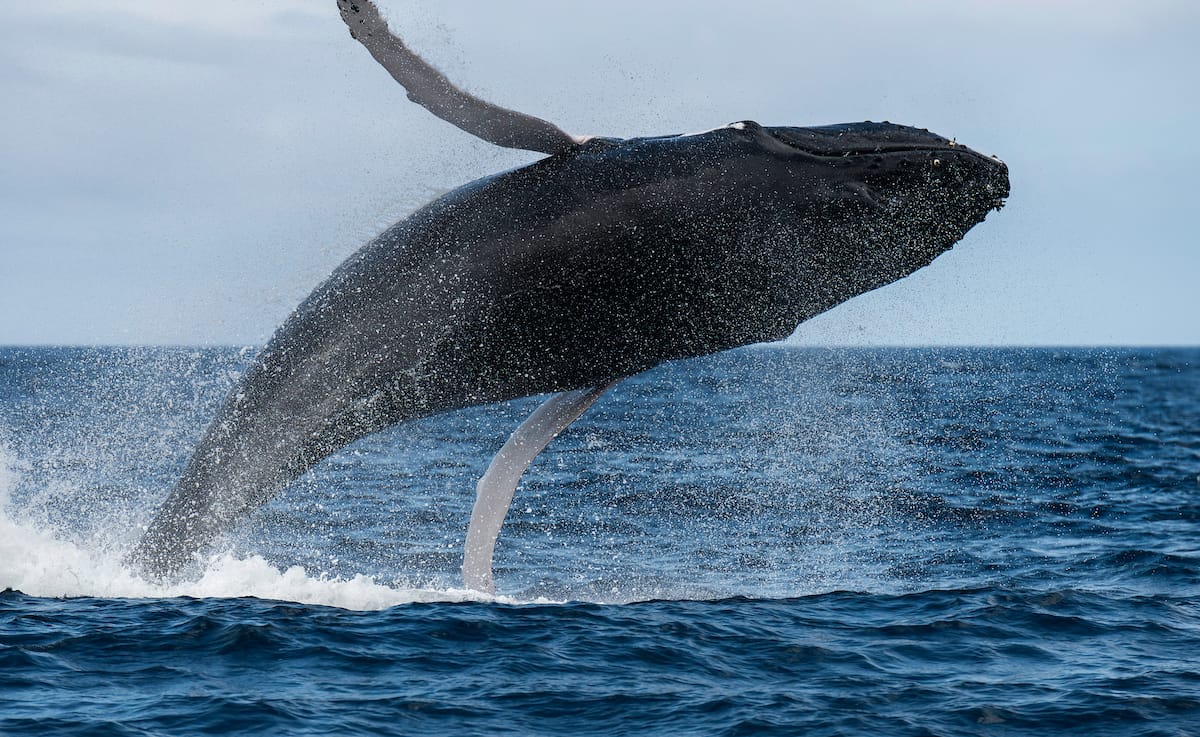
At the end of this guide, we also include a section with frequently asked questions (FAQ), seasonality info, and what to bring on the tour (including camera equipment).
Please let us know if you have any additional questions. Thanks!
In this post...
- Which Azores Whale Watching Tour is Best For You?
- Half-Day Sao Miguel Whale Watching Tours
- All Day Whale Watching Tours in Sao Miguel
- Pico Whale Watching Tours
- Terceira Whale Watching Tours
- Faial Whale Watching Tours
- FAQ About Whale Watching in the Azores
- What to Bring on Your Whale Watching Trip
- Whale Watching Photography Tips
- More Azores Travel Guides
Which Azores Whale Watching Tour is Best For You?
We have broken down each of these Azores whale-watching safaris into categories to help you see which one is right for you and the people you’re traveling with.
It also will include other island options if Sao Miguel is not your destination!
- Best Sao Miguel whale watching tour (half day): Dolphin and whale watching tour from Sao Miguel
- Best Sao Miguel whale watching tour (full day): Whale and Dolphin Watching with Vila Franca Islet Visit
- Best Pico whale watching tour: Whale watching in Pico with a biologist
- Best Terceira whale watching tour: Whale watching in Terceira (glass bottom boat!)
- Best Faial whale watching tour: Dolphin and whale watching from Horta
- Best Azores whale watching tour for kids: Dolphin and whale watching tour from Sao Miguel
If you have any other questions about which tour is right for you, feel free to shoot us a message!
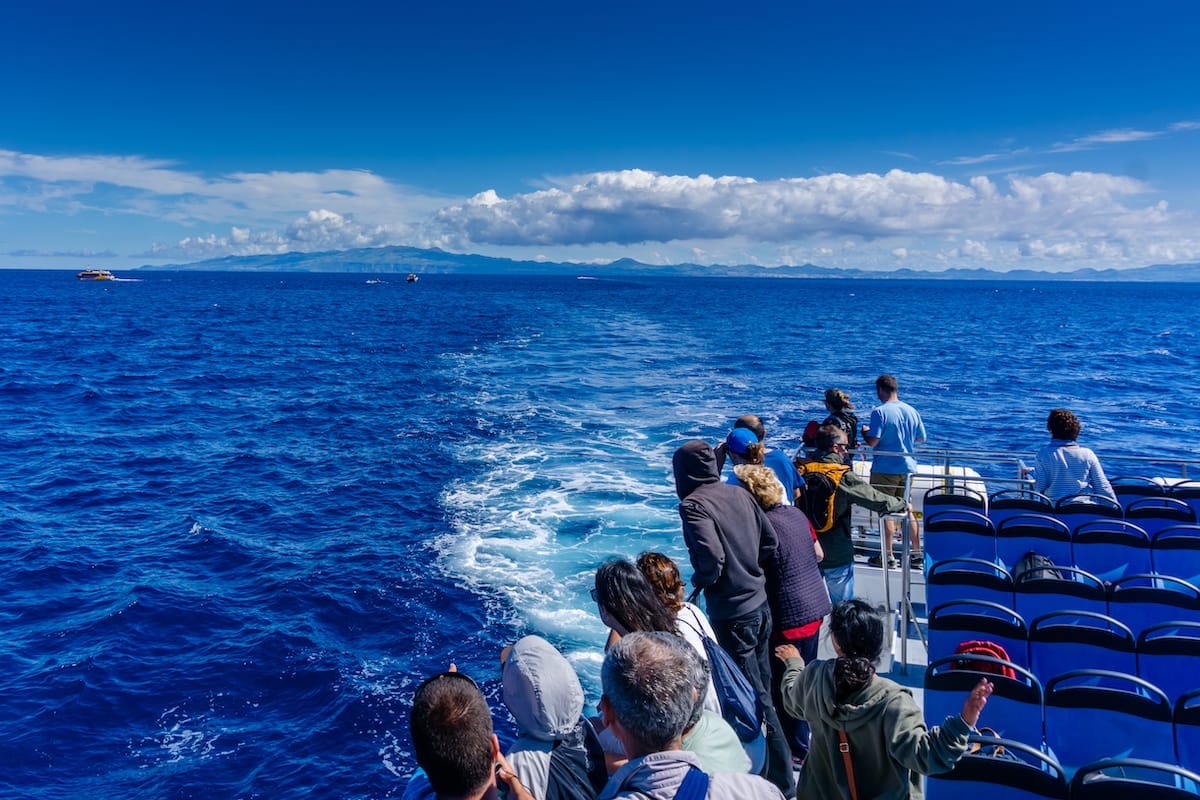
Half-Day Sao Miguel Whale Watching Tours
If you’re just solely looking for whale watching and a shorter day trip, these two tours will be your best bet when visiting the Azores.
They are both three hours and will leave you free to do other activities, excursions, and Azores tours that day.
1. Whale and Dolphin Watching Trip from Ponta Delgada (Top-Seller!)
Duration: 3 hours
Language: Portuguese, English
🐋 BOOK HERE
Another three-hour Azores whale watching trip, this tour will take you out from Ponta Delgada and you’ll have the chance to do a little whale watching.
This tour prides itself in the likely opportunity that you’ll get to see minke whales, dolphins, turtles, and more.
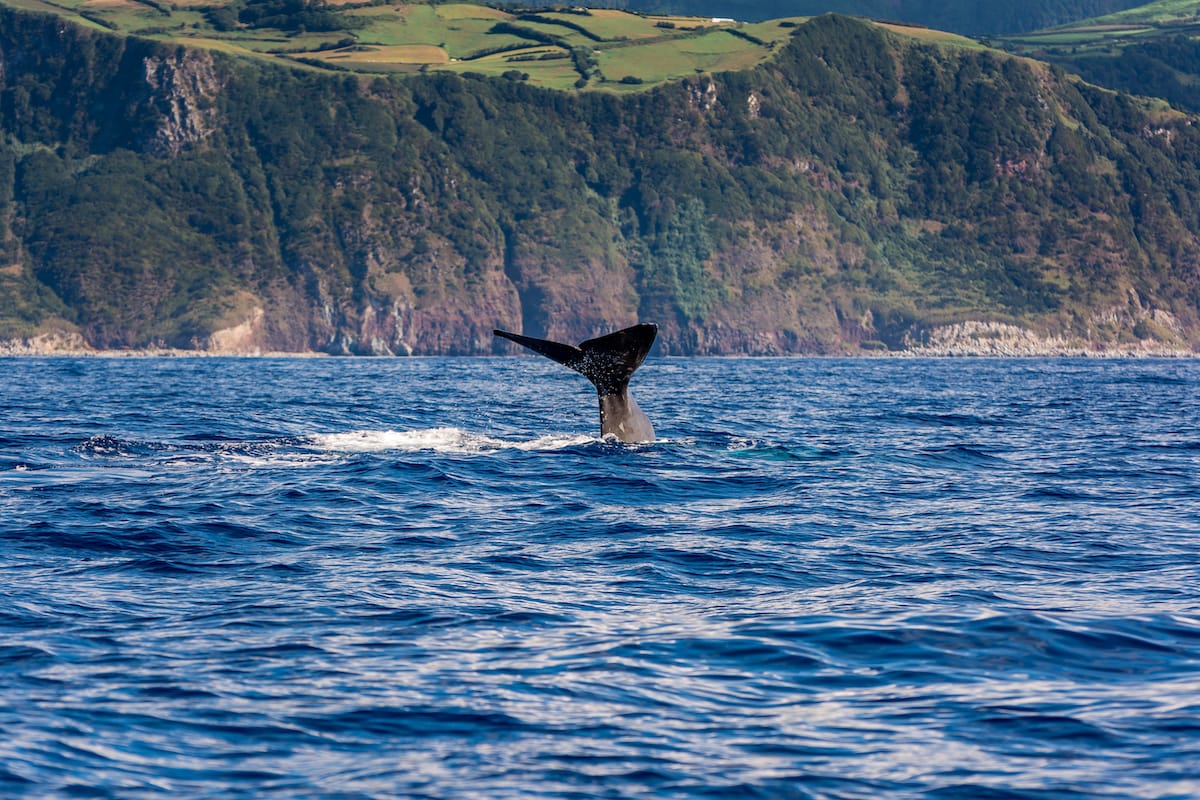
If you’re looking for something that is shorter and less expensive, this is definitely the tour for you and your travel companions! Hotel pickup in Ponta Delgada is not included in the price.
>> Click here to check tour rates and availability
2. Azores Whale Watching Expedition and Islet Boat Tour
Duration: 3 hours
Language: Spanish, Dutch, English, Portuguese, Italian, French, German
🐋 BOOK HERE
This tour departs from Ponta Delgada and lasts for 3 hours.
You will take to the sea in a RIB boat that fits anywhere from 12-28 people depending on bookings for the day.
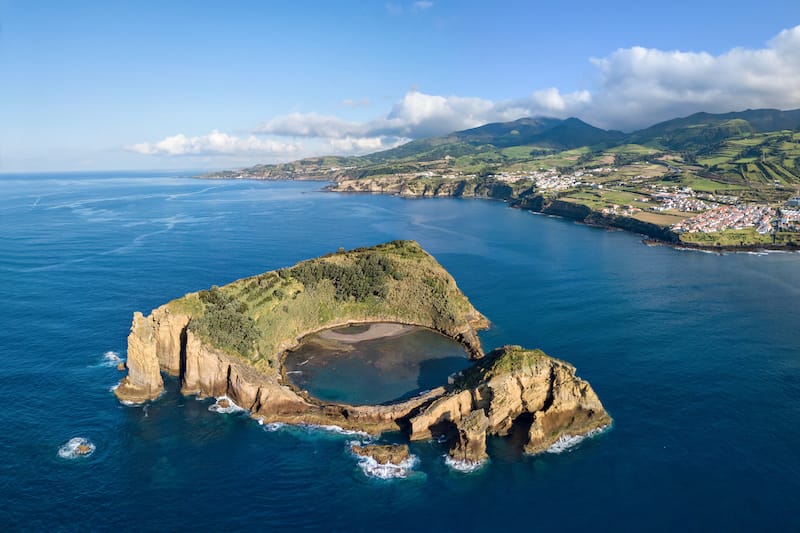
You will head to Vila Franca do Campo Islet and circle around it, offering you a view of the historic capital of the Azores, Vila Franca do Campo (destroyed in an earthquake in the 1500s).
Be sure to bring your own water for the journey as that and hotel pickup in Ponta Delgada are both not included.
>> Click here to check tour rates and availability
All Day Whale Watching Tours in Sao Miguel
There are quite a few whale-watching tours in Sao Miguel and I am only going to list two under the all-day section as they are both highly recommended and both include other activities in the process.
Please see below for additional details regarding each longer-duration tour.
3. Whale and Dolphin Watching with Vila Franca Islet Visit
Duration: 7 hours
Language: English, Portuguese
🐋 BOOK HERE
If you’re looking for an all-day whale and dolphin-watching tour in the Azores that is ethical, this is definitely a sound tour option for you.
The tour is 7 hours long and you will head to Vila Franca do Campo Islet, an island that is over in the historic capital of the Azores, Vila Franca do Campo (which was moved after the earthquake in the 1500s).
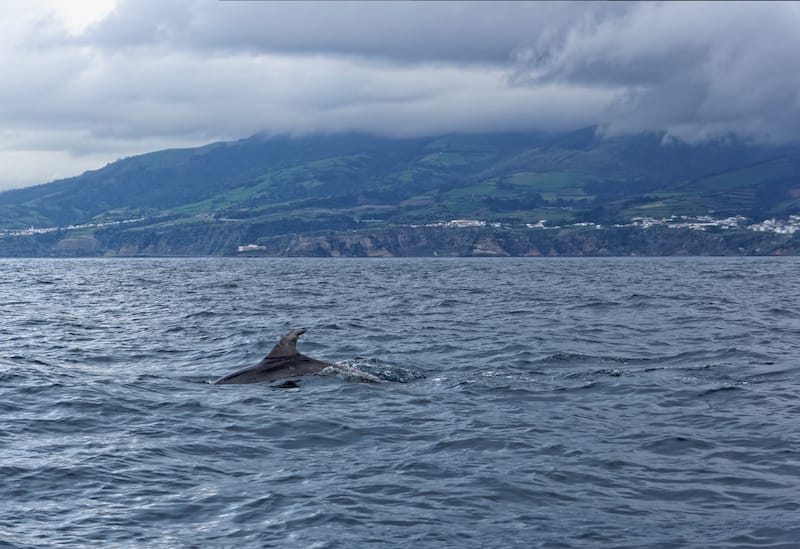
On this tour, you will also have a chance to snorkel at Villa Franca do Campo Islet which is quite a cool deal since the Azores limits the number of people allowed to go out there daily.
Lunch is included in a local restaurant (vegetarian options included).
Do bring your swimming gear with you if you wish and since snorkeling masks and gear are in limited numbers, bring your own if you wish. Hotel pickup is not included.
>> Click here to check tour rates and availability
4. Whales and Volcanoes Combo Tour with Lunch
Duration: 8 hours
Language: Spanish, French, English, Portuguese
🐋 BOOK HERE
This is a great option for those who want to do a little whale watching combined with another excursion.
The whale-watching part takes 3 hours and will take you out into the blue, Azorean waters searching for the Azores and Sao Miguel’s most-precious creatures before visiting the volcanoes that have shaped the landscapes and geography of the Azores.
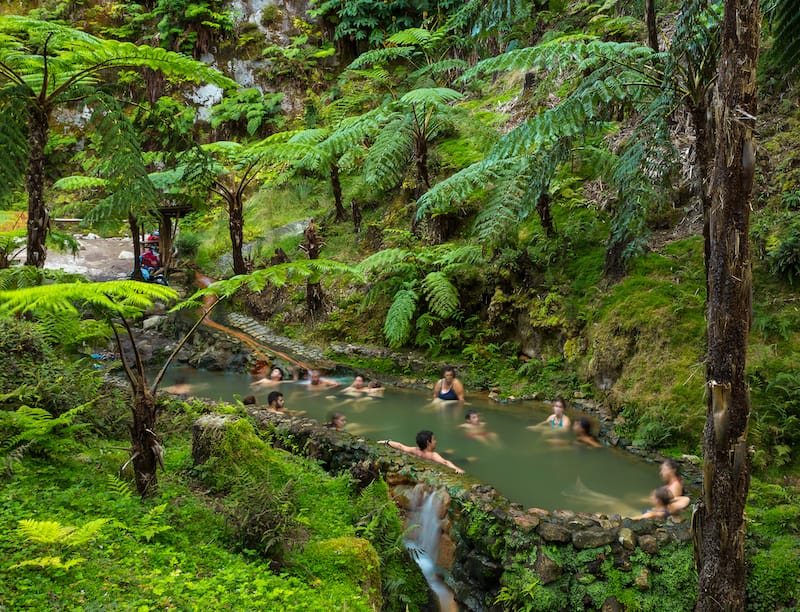
You will get to see Lagoa do Fogo and Caldeira Velha on this trip. A buffet lunch is included in the price, but the entrance fees are not.
Hotel pickup in Ponta Delgada is included in the tour price.
>> Click here to check tour rates and availability
Pico Whale Watching Tours
Pico is a fantastic place to go whale watching! If you’re whale watching in Pico, below are two recommended tours we suggest (both are quite different).
5. Pico Whale and Dolphin Watching (in a Zodiac Boat)
Duration: 3 hours
Language: Portuguese, English, Italian
🐋 BOOK HERE
On this Pico whale watching journey, you will have the chance to see whales, dolphins, turtles, and birds.
It will take you out to the sea on a Zodiac boat where you will get introduced to whales and dolphins by a marine expert!
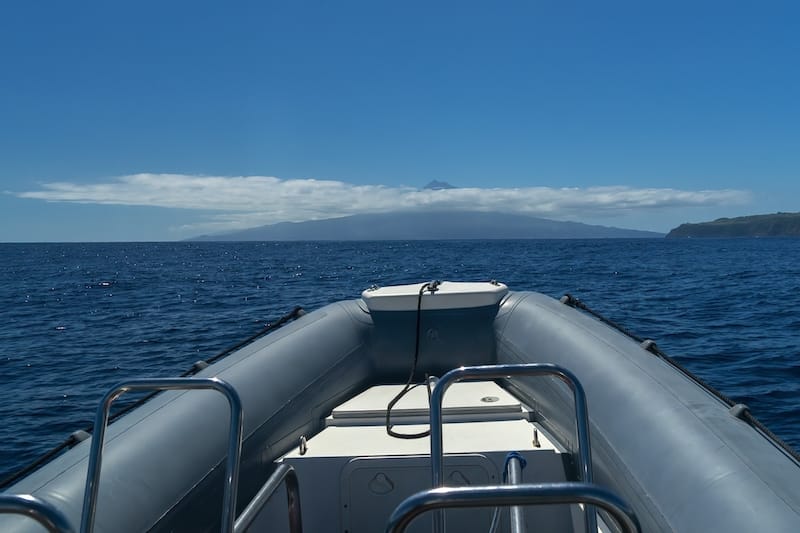
Your tour will leave from the town of Lajes do Pico and will return to the same place.
The tour includes a guide, skipper, waterproof top and life vest, and insurance. It does not include food and drinks or hotel pick-up/drop-off.
>> Click here to check tour rates and availability
6. Whale Watching in Pico (with a Biologist!)
Duration: 3 hours
Language: Portuguese, English, French
🐋 BOOK HERE
If you are keen to learn more about whales as you head to the Atlantic to view them, this is the tour for you!
This trip will take you to a dolphin and whale spot off of Pico where you can listen to marine biologists tell you everything about these large mammals.
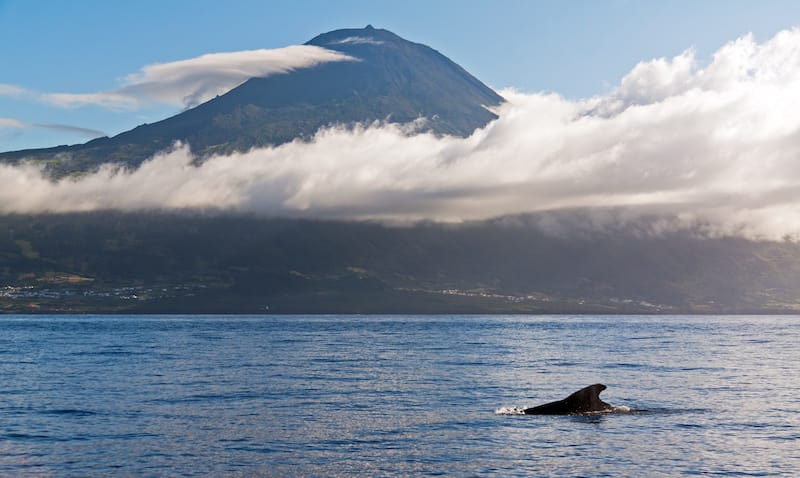
The day will begin at Lajes do Pico harbor where you will check in, get a briefing, and head on board! Your trip includes a life jacket, the guides, and a raincoat/pants if the weather is lousy.
Hotel pick-up/drop-off is not included. Food and drinks are also not included. This is not a wheelchair-friendly tour.
>> Click here to check tour rates and availability
Terceira Whale Watching Tours
Terceira is another fantastic place in the Azores to do a little whale watching! These are two of the top Terceira whale watching tours.
7. Whale Watching in Terceira (on a Glass Bottom Boat!)
Duration: 2.5 hours
Language: Portuguese, English, Spanish
🐋 BOOK HERE
This tour is likely to sell out during whale watching season – so book ahead! You will get to marvel at the Terceira coastline while you take to the sea to go view whales and dolphins in their natural environment!
Your tour will last for 2.5 hours and will be on a glass bottom boat that fits a max of 14 people (and has a 300-horsepower engine).
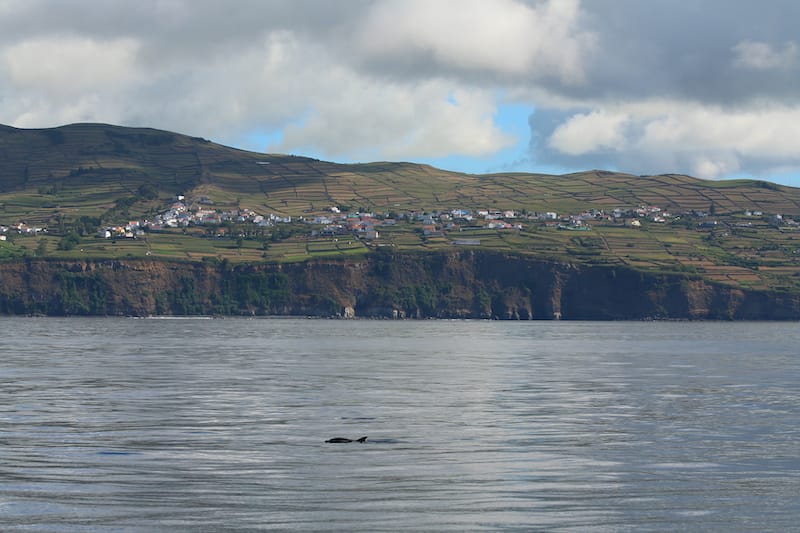
There is a 90% sighting success and the whale watching guide will have binoculars to help spot!
Hotel pick-up and drop-off are not included. Food and drinks are also not included. This tour will depart from the marina at Angra do Heroismo.
>> Click here to check tour rates and availability
8. Whale Watching and Jeep Combo Tour in Terceira
Duration: 8 hours
Language: Portuguese, English, Spanish
🐋 BOOK HERE
This combo tour pairs up a day of whale watching in Terceira with exploring the Azorean island by Jeep!
Your day will start on the sea while you observe whales and dolphins before heading to land where your Jeep will drive you off the path to see some of the more dramatic sights on Terceira.
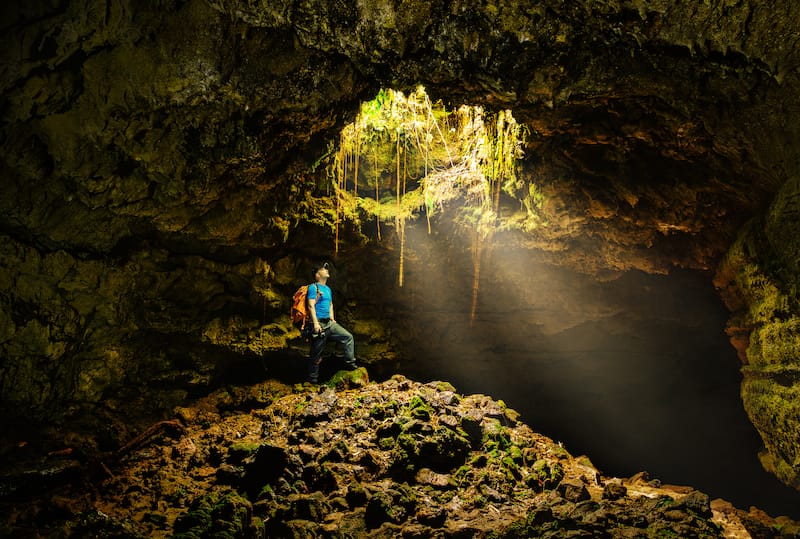
Roads are lined with stunning blue hydrangeas and you will love the day ahead of you!
Outdoor lunch with homemade food and drinks are included. Hotel pick-up and drop-off are also included. This is not a tour for those with mobility impairments.
>> Click here to check tour rates and availability
Faial Whale Watching Tours
Lastly, Faial is also a fantastic place to see whales out at sea! It is also a bit more ‘off the path’ compared to the other islands and will provide you with a unique experience. Below is one of the best whale watching tours in Faial.
9. Dolphin and Whale Watching in Faial (from Horta)
Duration: 3 hours
Language: Portuguese, English, French
🐋 BOOK HERE
On Faial, you will have a chance to join this whale watching tour that will work directly with whale spotters to locate dolphins and whales off the coast.
You’ll have a marine biologist to aid in learning about the mammals before you get to see them!
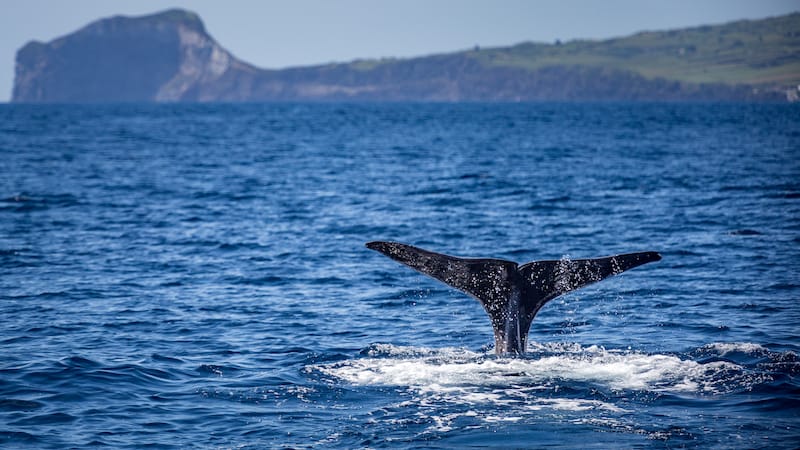
This will take you out on a RIB boat and there are two tours a day (one at 0900 and one at 1400). If you have back issues, this is not the tour for you.
Food and drinks are not included and hotel pick-up and drop-off are also not included.
>> Click here to check tour rates and availability
FAQ About Whale Watching in the Azores
About the Whales of the Azores
The Azores is one of the largest whale sanctuaries in the world, therefore making it one of the best places in the world to go whale watching!
These tiny islands in the middle of the Atlantic that are part of Portugal are home to over 28 species of cetaceans which is actually a solid third of the amount that exists worldwide.
The Azorean whales range from residents to migrants to the islands and some are seen better in certain seasons (which I detail below a bit more). The most commonly seen whales are sperm whales.
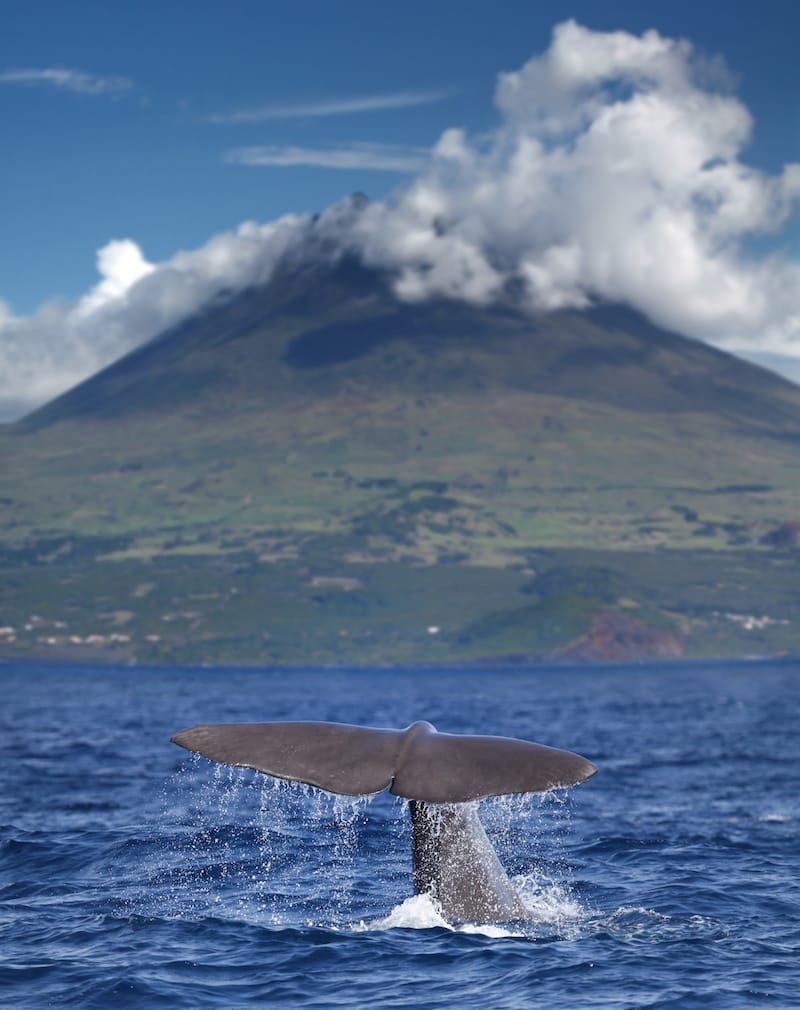
You will also see blue, fin, and sei whales depending on the season as they pass the Azores on their migratory paths. You will also have a pretty good chance of seeing humpbacks during the autumn season.
Another commonly spotted species are dolphins! You will have a really good chance to spot bottlenose, Atlantic spotted, and common dolphins when you’re on a whale-watching tour in the Azores.
Best Season for Whale Watching in the Azores
The best Azores whale watching season is April and May!
This is when you can see the majority of species that exist in the nearby waters regardless of whether they call the Azorean waters home or are simply passing through.
This is when the bigger whales come out to play.
But, the overall whale watching season in the Azores is from April until October. During the spring months, you can see larger whales like blue, fin, and sei whales.
In the autumn, you will see humpbacks. Sperm whales are around year-round feeding on large squid deep in the Atlantic waters.
Things to Know Before Whale Watching
Before I went on a whale watching trip, there are a few things I wish I had known. These are those tips or facts about Azores whale watching:
Whale watching in the Azores is kind of a newer thing for tourism.
Whaling was actually legal in the Azores and when the islands decided it no longer served a purpose there, they converted all whaling areas, boats, and the men who did the whaling into whale-watching tour owners, guides, and enthusiasts.
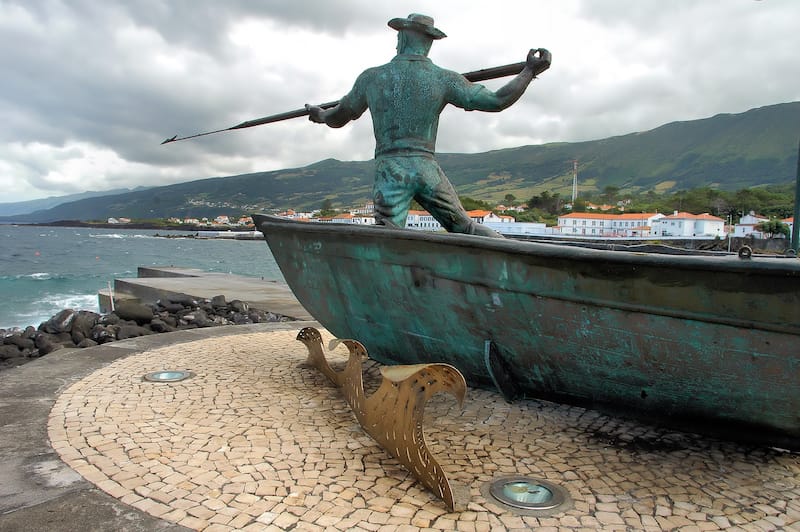
How cool is this? Taking an industry that slaughters whales into one that takes pride in the majestic creatures… it is just remarkable.
You are not guaranteed to see any whales. Please don’t get mad at the tour company for this.
It is, obviously, not their fault. The creatures have their own patterns and behavior and while the companies have a pretty good insight as to where the whales are, they are not going to lure them to the boat or up out of the water simply for you to take a photo and ooh and aww over them.
The Azores’ weather is not what you may think. Sun is common, but so is rain. How else would the islands stay lush and green? At least you’re not whale watching in Tromso where it will be snowy and dark!
Bring the proper equipment for rainy weather. I detail below what I suggest bringing on an Azores whale watching tour.
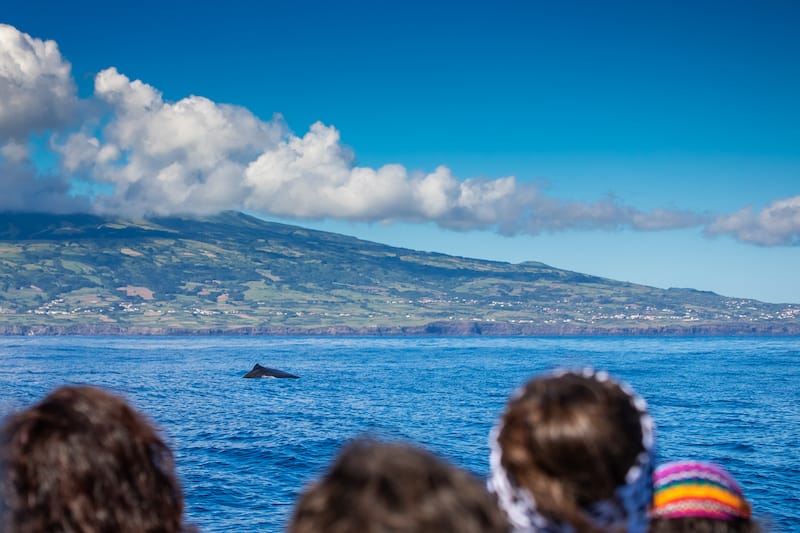
You will most likely be on a RIB boat if on Sao Miguel. For those who have never been on a RIB boat, it is a small, inflatable boat. It can go fast, or sit and rock in the water.
You have a good chance to get wet on this boat- so dress accordingly and have the right camera equipment for such. It also could be cold as you go against the wind, so dress warmly.
What to Bring on Your Whale Watching Trip
There are not too many recommendations for what to bring as most people in the Azores take part in a shorter tour, but here are a few recommendations I have.
- Seasickness wristband (sea bands are lifesavers for those that get seasick – Dramamine works wonders too)
- Dry bags (great for the elements and keeping camera equipment dry)
- Waterproof bag/case for your phone (great for RIB boat tours)
Whale Watching Photography Tips
If you’re looking to do some Azores photography on your whale-watching trip, be sure you have the right equipment for the job.
I have never done a whale-watching tour on a RIB boat, actually, but I have been on one for other purposes and found it quite hard to photograph because I’m an amateur and I had bad lighting (was during the winter).
Be sure to have a camera where you can use manual settings or sport mode for that quick shutter speed. You will only have a split second to catch these creatures doing their thing each time!
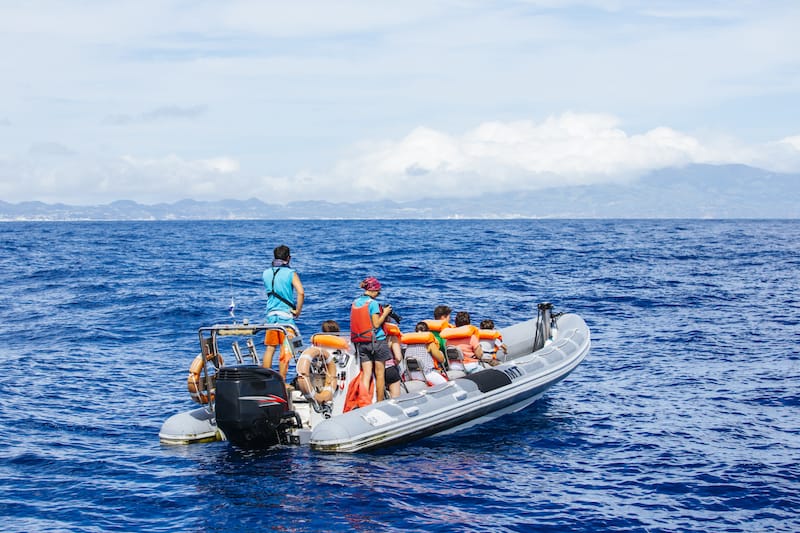
If you’re on a catamaran, you will have an easier time, but there could be a chance you’re surrounded by more people and they may hinder your shots. I would bring a tripod on a catamaran.
Try to also have a remote to attach to the camera. A zoom lens is imperative, of course.
If you’re using your phone to photograph whales, you may struggle to capture the images you want in a high-quality format. Below are the lens and camera equipment I suggest for Azores whale-watching photography:
- Your camera (the best camera you have is the one in your hand – is what everyone tells you!)
- Zoom or telephoto lens (you’re supposed to be at a distance from the whales at all times so this helps you get that shot!)
- Tripod (helps with low-light situations and rough seas!)
- Remote (good for quick shots)
- Lens cleaner (if there is rain or seawater splashing up – you’ll be grateful for this!)
- GoPro10 (great for the RIB boat tour!)
Have you ever been whale watching in the Azores? If so, please drop your tips and suggestions into the comments section for future travelers! Thanks!
More Azores Travel Guides
- Best things to do in Terceira
- Ultimate Azores itinerary
- Waterfalls in the Azores
- Best things to do in Pico
- Visit the Azores
- Best places to stay in the Azores
- Sao Vicente Lodge
- Snorkeling in the Azores
- Scuba diving in the Azores
- Sailing in the Azores
- Best Azores tours
- Azores packing list
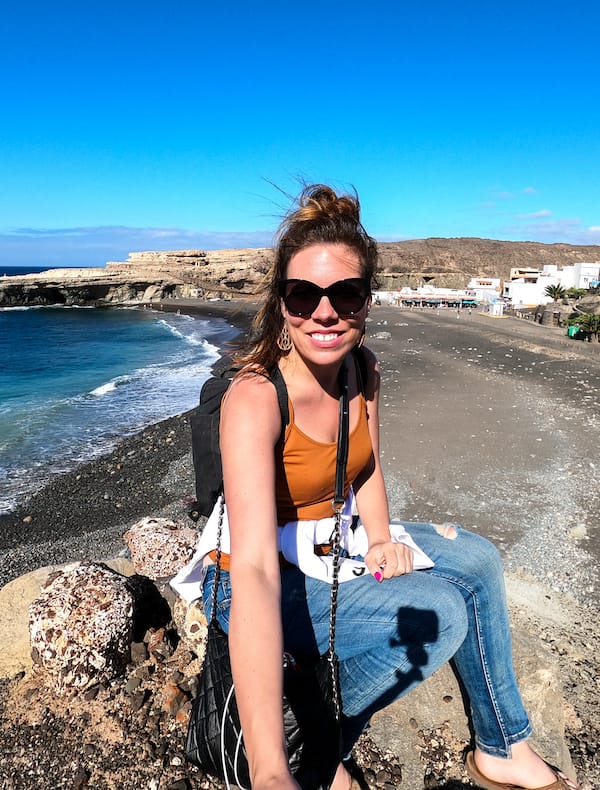
Megan is a travel blogger and writer with a background in digital marketing. Originally from Richmond, VA, she now splits her time between Frankfurt, Germany and Arctic Finland after also living in Norway, Armenia, and Kazakhstan. She has a passion for winter travel, as well as the Nordic countries, but you can also find her eating her way through Italy, perusing perfume stores in Paris, or taking road trips through the USA. Megan has written for or been featured by National Geographic, Forbes, Lonely Planet, the New York Times, and more. She co-authored Fodor’s Travel ‘Essential Norway’ and has visited 45 US states and 100+ countries.

I recently returned from a trip to the Azores (10/2019) and a whale watching excursion. I used a Nikon D-500 with a 28 – 300 mm zoom lens and a ND filter to bring out the blue skies. I guess this would be considered a medium/high end camera. I set the shutter to “continuous – low” and let it chug away taking pictures as the sperm whales did their thing; blowing, tails in the air and getting ready to dive. I would have missed some great shots if I would have had the shutter set to “single shot”. I think a tripod would have been just one more piece of equipment for me to worry about and really didn’t want the extra weight on the planes or on the catamaran. I compensated for lack of a tripod by making sure my shutter speed was set a little higher than normal. It is somewhat gratifying when the marine biologist comes around to show you whale pictures from other excursions, see your pictures and then go and get the other marine biologist to also look at your pictures. This was a great experience.